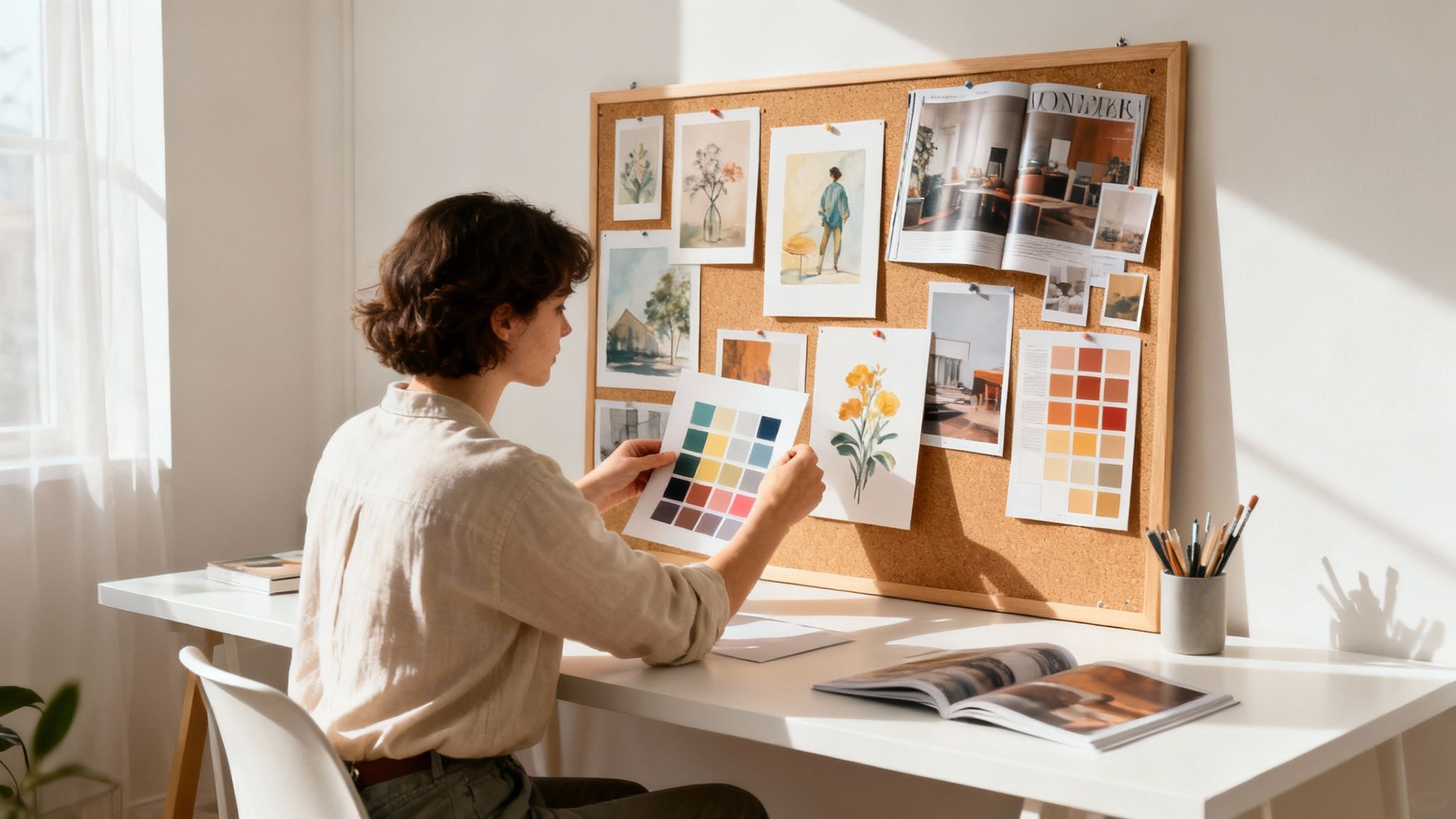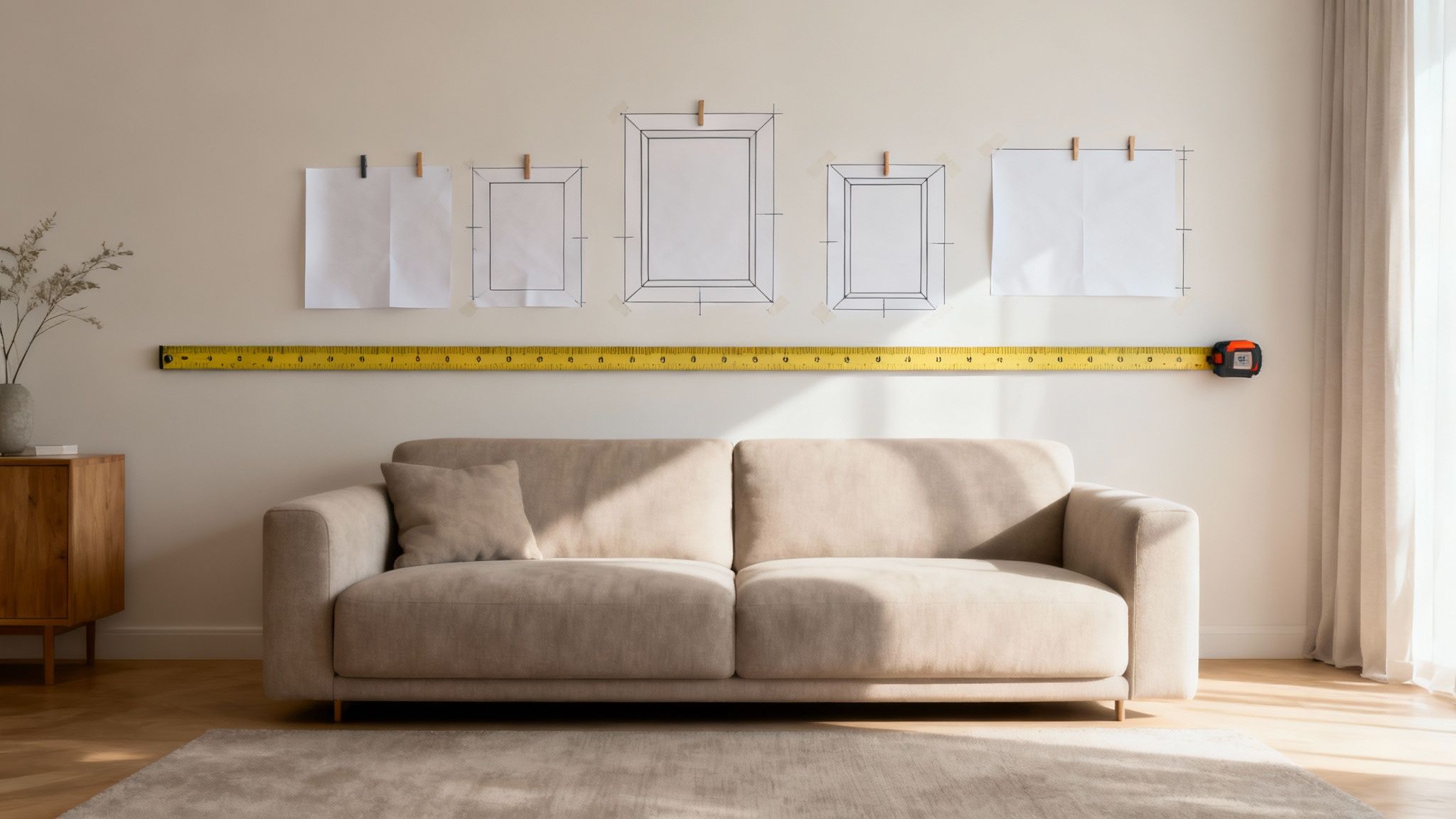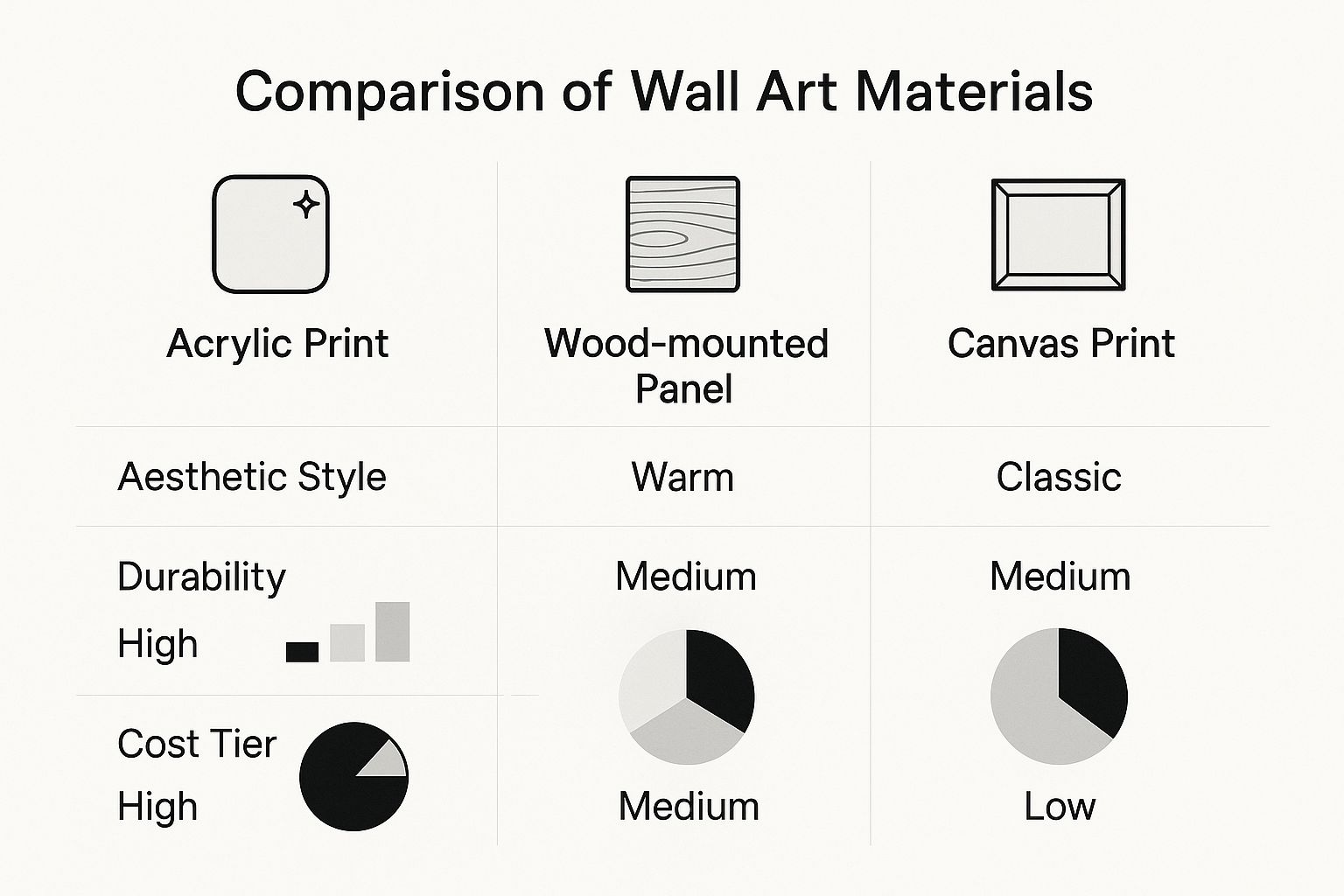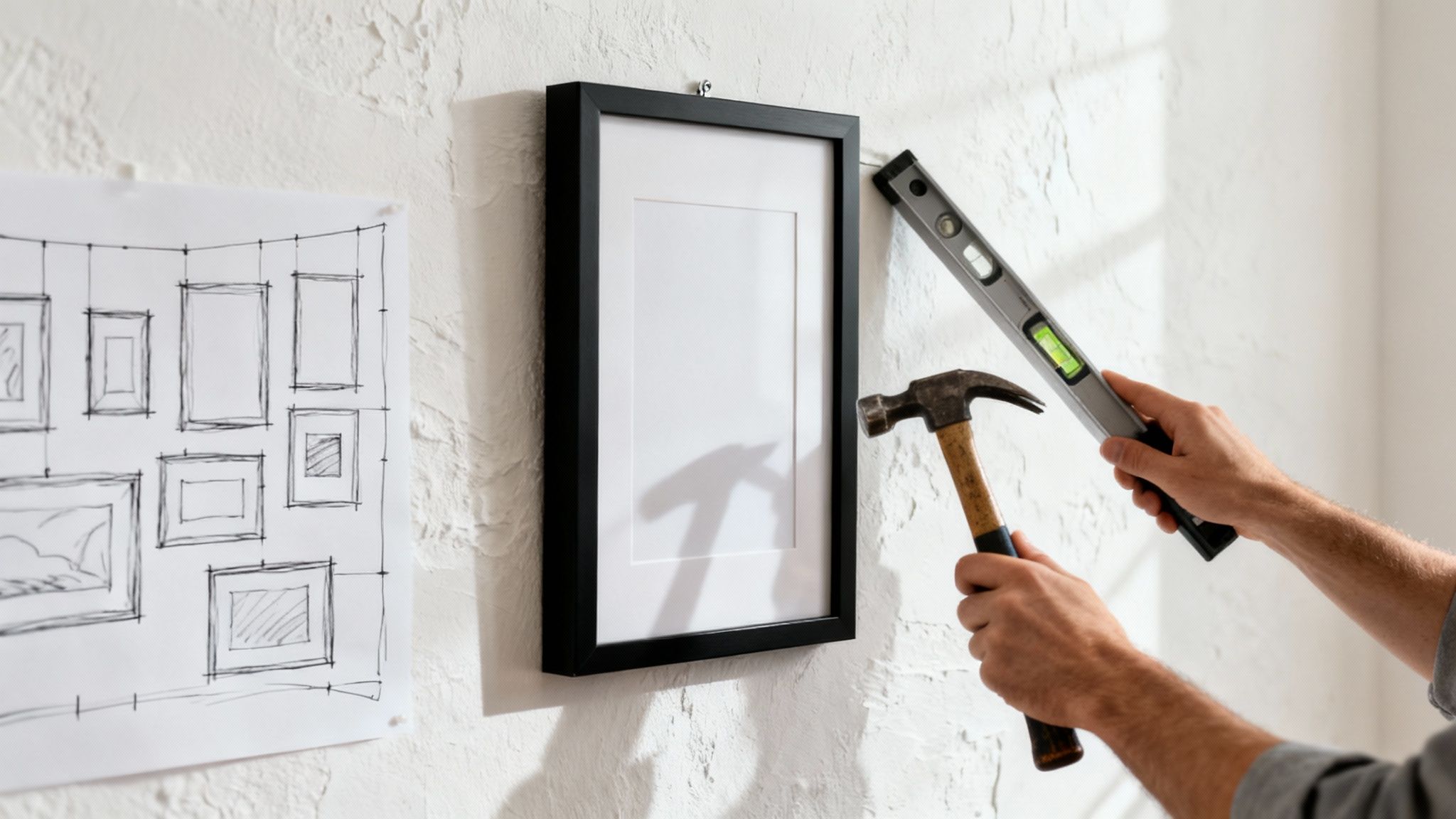We've all been there. That giant, empty wall is just... staring. It’s practically begging for something, but the thought of choosing the perfect piece of art can feel a little daunting. Let's be honest, it's more than just filling a space; it’s about making your house feel like a home.
So, Why Does Finding the Perfect Wall Art Actually Matter?
Think of wall art as the final, and most personal, layer of your home's design. It's the exclamation point at the end of a sentence. The right piece can completely transform a room from "nice" to "wow," tying everything together and injecting your unique personality into the four walls you live in.
It’s not just about what looks good, either. Art has a real impact on how a room feels. A calming, minimalist print can turn your bedroom into a serene retreat, while a bold, energetic abstract can inject some much-needed life into your living room. It's your chance to tell a story and set the mood.
We All Want a Home That Feels Like Us
It's no surprise that Aussies are getting more and more interested in creating homes that truly reflect who they are. The Australian home decor market is booming—valued at around USD 15.6 million in 2024, it's projected to hit USD 21.0 million by 2033. That's a lot of people ditching the generic for the personal!
Consider this guide your friendly co-pilot on this creative mission. We're going to skip the stuffy, old-school rules and focus on what actually works. For some extra tips from the pros, you can also check out this great article on how to choose wall art like an interior designer.
Key Takeaway: Choosing wall art is a powerful way to express your identity and set the emotional tone of your home. It's a final, crucial step in making a house feel like a home.
Ready? Let’s dive in and find art you’ll absolutely love for years to come.
Quick Guide to Choosing Wall Art
Before you even think about hitting 'add to cart', take a moment to run through these core ideas. A little prep work now saves a lot of headaches (and returns!) later.
| Key Element | What to Consider | Quick Tip |
|---|---|---|
| Your Style | What's your vibe? Modern, boho, classic? Look at your furniture and existing decor for clues. | Create a Pinterest board and pin images you're drawn to. You'll see a pattern emerge! |
| The Room | What's the purpose of the space? Is it a busy living area or a quiet bedroom? | The art should match the room's energy. Vibrant pieces for social spaces, calming ones for private retreats. |
| Scale & Size | How big is the wall? How high are the ceilings? | When in doubt, go bigger. A small piece on a large wall often looks like a postage stamp. |
| Colour Palette | Do you want the art to blend in or stand out? | Pull a secondary colour from your existing decor (like a cushion or rug) to feature in your artwork. |
This little checklist is your secret weapon. Keep these points in mind, and you'll be well on your way to choosing art with the confidence of a seasoned decorator.
So, What's Your Art Vibe?

Before we get bogged down in measurements and colour palettes, let’s start with the fun bit: figuring out what you actually like. This has nothing to do with art history exams or knowing your Monets from your Manets. It’s all about what makes you tick. The art on your walls should be a slice of your personality, not just something you bought because it matches the couch.
Have a think. When was the last time a piece of art, a photo, or even a killer sunset view stopped you in your tracks? What grabbed you? Was it the chilled-out vibe of a beach scene, the chaotic energy of a wild abstract, or the timeless cool of a black-and-white photo? These are the breadcrumbs leading back to your personal style.
Map Out Your Taste
The absolute best way to nail down your style is to start gathering things that catch your eye. It’s like a detective mission, but the only mystery you’re solving is your own taste. Don't just stick to art galleries—cast your net wider and look at interior design magazines, fashion photography, even album covers.
A mood board is your best friend here. You can go old-school with a corkboard and some pins, or dive into the digital world with Pinterest. The trick is not to overthink it. If an image makes you feel something good, save it.
After a week or so of this visual treasure hunt, take a look at your collection. You'll start to see patterns emerge, almost like magic.
- Colour Cravings: Are you all about those earthy, neutral tones, or do you gravitate towards bright, bold jewel colours? Maybe soft pastels are more your jam.
- Favourite Subjects: Is your board filled with sweeping landscapes, bustling city scenes, interesting faces, or just cool abstract shapes?
- The Overall Mood: Does your collection feel calm and serene, or is it buzzing with energy and drama?
Suddenly, that vague "I know what I like when I see it" feeling starts to take shape. This little exercise gives you a clear roadmap, making it so much easier to spot the perfect piece that feels 100% you.
Think of your personal art style as the visual language of your home. It’s not about chasing trends; it’s about creating a space that genuinely reflects who you are and what you love.
Look Local, Think Cultural
Your style doesn't exist in a vacuum. It can be powerfully shaped by where you live and your own heritage. Here in Australia, there's a massive and well-deserved movement towards celebrating original, culturally rich artworks. We’re seeing a huge surge in the market for Indigenous Australian art, and for good reason.
In the first half of 2025 alone, sales rocketed to an incredible AUD 11.7 million. That number says a lot about our collective hunger for art that is authentic and steeped in story. You can get the full rundown in this mid-year art market report.
Leaning into these local influences can add a whole new layer of meaning to your home. It transforms your walls from just decorated surfaces into a true celebration of culture and place. Getting a handle on your personal style is the first, most crucial step to choosing art with confidence.
Getting the Size and Scale Just Right

Here's where so many well-intentioned decorating plans go a bit sideways. You can find the most incredible piece of art, but if the scale is wrong for your wall, it will always feel… off. Think of it like a beautiful suit that’s two sizes too small; it just doesn't work, no matter how great it is.
Getting the scale right isn’t about following rigid rules, but about creating a sense of visual harmony.
And the biggest mistake we see? People going too small. A tiny print floating in the middle of a huge wall looks lonely, accidental, and completely underwhelming. Trust me on this one: when in doubt, it’s almost always better to choose a piece that feels a touch too big than one that’s obviously too small.
The Foolproof Furniture Formula
Hanging art above a sofa, bed head, or console table is a classic design move for a reason. And luckily, there’s a simple trick the pros use to get it perfect every time. You want your artwork to be roughly two-thirds to three-quarters the width of the furniture it’s hanging over.
Let's say your sofa is 200cm wide. You should be on the hunt for a piece (or a collection of pieces) that measures somewhere between 133cm and 150cm across. This little rule of thumb creates a beautiful, balanced anchor point that visually connects the art to the furniture beneath it.
Don't forget the gap! You'll also want to make sure the bottom of the frame is about 15-20cm above the furniture to give it some breathing room.
An undersized piece of art can make your entire room feel out of proportion. The right scale not only complements your space but also gives the artwork the presence and impact it deserves.
Large Statement vs. Gallery Wall
The choice between one massive, show-stopping piece and a collection of smaller ones can completely change a room's vibe. Each path offers a unique feel, and the right one really depends on the story you want your walls to tell.
- The Single Statement Piece: This is your big, confident, dramatic option. A large-scale artwork creates an instant focal point and is perfect for commanding attention in a living room or at the end of a long hallway. It’s a fantastic way to showcase a single, powerful image you absolutely adore.
- The Curated Gallery Wall: A gallery wall is personal, dynamic, and wonderfully eclectic. It’s your chance to play curator, mixing and matching different sizes, mediums, and frames to tell a more complex story. This is also a brilliant solution for those awkward, hard-to-decorate walls or for anyone who simply can’t commit to just one piece!
Thinking about how to tackle a tricky area? A gallery wall can be a lifesaver in tight spots. If you're looking for a bit more on this, our guide on how to decorate small spaces has some great ideas.
Before you do anything else, grab a tape measure. Measure your wall, measure your furniture, and then use painter's tape to mark out the potential art sizes directly on your wall. This simple step helps you see the scale in real life before you commit, saving you from any size-related buyer's remorse down the track.
Navigating Colour Palettes and Materials
Right, let's get into the fun stuff: colour and material. These are the two things that can truly make or break your wall art. Get them right, and you've got a room that just sings. Get them wrong, and... well, it can feel like a house guest who just won't leave.
Think of colour as the emotional heartbeat of your space. The right palette is like the perfect background music—it ties everything together, from the sofa to the walls, creating a seamless, intentional vibe.
Choosing Your Colour Strategy
When it comes to picking colours for your art, you’ve got a few ways to play it. Each one sets a completely different mood, so have a think about what you want the room to feel like.
-
The Harmonious Approach: This is your go-to for a calm, pulled-together feel. Take a good look at the existing colours in your room—the cushions, that favourite rug, the throw on your armchair. Then, choose art that echoes those same tones. If your living room is all about navy blue and soft grey, a moody landscape with stormy blues and misty greys will feel like it was made for the space.
-
The Complementary Pop: Feeling a bit bold? This is for you. Whip out a colour wheel and find the shade directly opposite your room's dominant colour. Got a lot of calming blue? A piece with a splash of vibrant orange will create a killer contrast that feels energetic and confident. It’s a guaranteed head-turner.
-
The Neutral Ground: For an understated, sophisticated look, you can never go wrong with neutrals. Art that plays with black, white, grey, or beige adds texture and depth without yelling for attention. This is a brilliant choice for a timeless look, and it’s an absolute must for minimalist spaces. For a deeper dive, check out our guide on minimalist home decor ideas to really nail this aesthetic.
Here’s a pro tip: don't get hung up on matching colours perfectly. It can look a bit stiff and staged. Instead, aim for tones that complement each other. The result is always more natural and effortlessly stylish.
Material Matters More Than You Think
The image is one thing, but the material your art is on? That’s a whole other layer of personality. The physical presence of the piece—its texture, its finish—has a huge impact on the room's atmosphere. It’s what separates a rustic, earthy vibe from a sleek, contemporary one.
And it’s not just about looks. A piece hanging in a steamy bathroom needs to be way more durable and moisture-resistant than one chilling out in a dry, climate-controlled living room.
This little infographic breaks down the style, durability, and cost of three of the most popular materials out there.

As you can see, an acrylic print gives you that slick, modern look and is built to last, but it'll cost you a bit more. On the other hand, a classic canvas is friendlier on the wallet. It’s all about balancing the look you love with a budget you can live with.
Finding and Funding Your Art
Alright, let's get to the best part: the treasure hunt! Finding art you absolutely love doesn't mean you need to remortgage your house. The art world is massive, with incredible options out there whether your budget is leaning towards instant noodles or a fancy degustation.
One of the first things you'll weigh up is original art versus high-quality prints. An original piece is a one-of-a-kind deal – something that's uniquely yours and holds a special energy. Prints, on the other hand, are the great democratisers of art. They make stunning works accessible and affordable, letting you bring home a piece you adore without the eye-watering price tag.
Honestly, there’s no right answer here. It all comes down to what feels right for you and your bank account.
Where to Find Your Perfect Piece
Forget the old idea that art only lives in stuffy, silent galleries where you're scared to breathe too loudly. Your next masterpiece could be hiding in some truly unexpected places. It's time to think outside the frame and explore a few different avenues.
- Online Galleries: Websites like Etsy or our local Aussie hero, Bluethumb, are bursting with independent artists. You can find everything from original paintings to limited edition prints, and often you get to chat directly with the person who made it.
- Local Art Fairs & Markets: Keep your eyes peeled for local markets and art fairs. They’re a fantastic way to discover up-and-coming talent right in your own community and snag unique pieces that tell a local story.
- Op-Shops and Vintage Stores: Never, ever underestimate the thrill of the thrift! You can unearth stunning vintage prints, quirky frames, or even original paintings for a steal. It’s a sustainable, budget-friendly way to inject some serious character onto your walls.
- Print-on-Demand Services: Found a gorgeous high-res public domain image from a museum archive, or want to blow up one of your own photos? Services like this can turn your favourite digital images into gallery-worthy canvas or framed art.
Here’s a modern-day secret weapon: Augmented Reality (AR). The digital age has completely changed the art-buying game. Forget guesswork; you can now shop with more confidence than ever before. Many online galleries have AR tools that let you use your phone's camera to see exactly how a piece will look on your wall before you even think about clicking "buy".
This tech has seriously shifted how we shop. Digital platforms and social media have blown open the doors to art discovery, and these AR visualiser tools give us the confidence to make the right choice. If you're curious about the data, you can see how digital tools are shaping the wall art market on futuremarketinsights.com.
Art Sourcing Options Compared
Feeling a bit overwhelmed by the options? Let's break it down. Each source has its own vibe and benefits, depending on what you're looking for.
| Source | Best For | Price Range | Key Consideration |
|---|---|---|---|
| Online Marketplaces | Discovering independent artists, wide variety | $$ - $$$$ | Read reviews and check the artist's return policy. |
| Local Art Fairs | Finding unique, local talent and meeting creators | $$ - $$$ | A fantastic way to support your local creative community. |
| Op-Shops/Vintage | One-of-a-kind finds, character, and bargains | $ - $$ | It's a treasure hunt! Condition can vary, so inspect carefully. |
| Galleries | Investment pieces and established artists | $$$$ - $$$$$ | You're paying for curation and artist reputation. |
| Print-on-Demand | Customisation, personal photos, affordability | $ - $$$ | Quality can vary greatly between services; look for samples. |
Ultimately, mixing and matching from different sources is often the best way to build a collection that feels personal and layered.
Setting a Realistic Art Budget
Figuring out what to spend can feel a bit like guessing, but a little bit of planning makes all the difference. One pro tip: your budget needs to cover both the art and the framing. Seriously, custom framing can sometimes cost as much as the print itself, so don't let it be a nasty surprise.
If you’re just dipping your toes in, a great first step is to browse for unique home decor online to get a feel for the going rates. You’ll see that a small, unframed print from an emerging artist might be under $100, while a massive, professionally framed original could easily run into the thousands.
Set a clear budget for the room or the project before you fall in love. By exploring all these different sources and being smart about when to splurge on an original versus a great print, you can absolutely find stunning art that makes your home sing without breaking the bank.
Hanging and Arranging Your Art Like a Pro

So, you’ve found it—the perfect piece of art. The hunt is over! But hold on, the job isn't quite done. Getting it up on the wall is where the real magic happens, and how you hang it can make or break the entire vibe. Poor placement can make even the most incredible artwork feel… well, a bit weird and out of place.
Let’s start with the golden rule, a little secret straight from the gallery world: hang your art so its centre point is about 145cm from the floor. This isn't just a random number; it's the average person’s eye level. This simple trick makes the art feel instantly connected to the viewer and properly grounded in the room.
Nailing the Gallery Wall
Feeling ambitious and ready to go beyond a single piece? A gallery wall is an absolutely brilliant way to let your personality shine. The trick is to aim for curated balance, not just beautiful chaos. Before you even think about touching a hammer, lay all your pieces out on the floor. This is your playground to shuffle things around and find an arrangement you love.
- Embrace Variety: Don't be afraid to mix things up! Combine different frame styles, play with various sizes, and throw in both portrait and landscape orientations for a dynamic, collected-over-time feel.
- Create a Common Thread: To keep it from looking like a jumble sale, find a way to tie it all together. This could be a consistent colour palette running through the art or a shared theme that connects each piece.
My best tip? Avoid a cluttered mess by keeping the space between your frames consistent. Aim for about 5-8cm between each one. This creates a subtle visual grid that feels intentional and organised, even with the most eclectic mix of art.
Once you have your art and your plan, the final step is mastering the display. If you want to dive deeper, you can learn all the expert tricks on how to arrange wall art like a pro. With these tips up your sleeve, your walls will look less like an afterthought and more like a deliberate, polished collection.
Still Stumped? Let’s Tackle Those Lingering Wall Art Questions
Right, so you've nailed down your style and have a measuring tape in hand. But just when you think you're ready to start hanging, a few nagging questions can bring the whole project to a grinding halt. It happens to everyone.
Let’s clear up these common head-scratchers so you can move forward and get that art up on the wall with confidence.
Does Everything Have to Match Perfectly?
Oh, heavens no! Please don't. A room where every piece of art is perfectly coordinated can feel a bit sterile, like a hotel lobby instead of a home with a story. The most inviting spaces feel like they’ve been curated over time, not bought in a single shopping trip.
The goal isn't matching; it's cohesion. You want your art collection to feel like it's in conversation, not in uniform. You can tie wildly different pieces together with a common thread.
- Maybe it's a splash of the same bold blue that appears in each piece.
- Perhaps the theme is consistent, like a love for coastal landscapes or abstract cityscapes.
- You could even unify everything with a similar frame style—all simple black frames, for example, can make a chaotic collection feel instantly intentional.
This way, your gallery wall looks thoughtfully curated, not just thrown together.
Can I Really Put Art in the Kitchen or Bathroom?
Absolutely! These rooms are often overlooked, but a great piece of art can make a powder room feel like a little jewel box or give your kitchen some much-needed personality. The trick is to choose wisely, because steam and splashes are the natural enemies of art.
Humidity is the big factor here. Delicate paper prints or raw canvases are a recipe for warped, mouldy disaster. Instead, you need to think about durability. Look for art that can handle a bit of moisture, like acrylic prints, sleek metal prints, or anything professionally framed behind glass. These materials create a protective barrier against the elements.
As for what to hang? Have some fun with it! A collection of botanical illustrations can turn a bathroom into a spa-like retreat, while a quirky food-themed print is a perfect conversation starter in the kitchen.
If there's one mistake I see time and time again, it's choosing art that's way too small for the wall. A tiny, lonely piece just looks like an afterthought. When in doubt, go bigger than you think you need, or group smaller pieces together to make a single, powerful statement.
Ready to find that piece that just clicks? Dive into the incredible collection at AMI Cart and find art that truly speaks to you. Hop over to https://amicart.au and let the treasure hunt begin.



